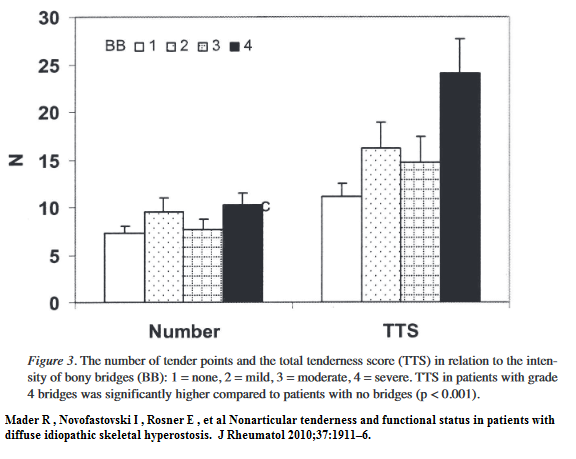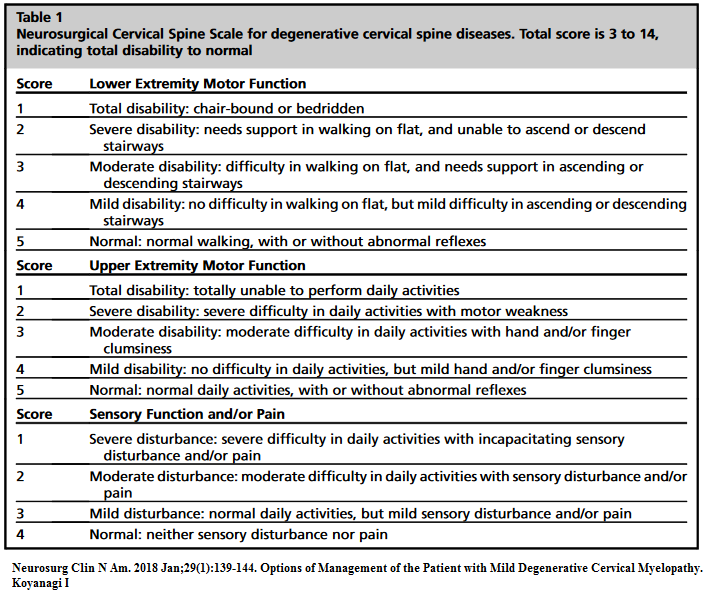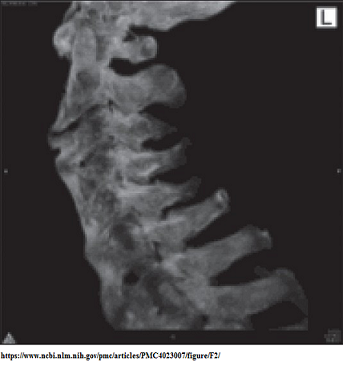Diffuse idiopathic skeletal hyperostosis (DISH) is were you get extensive ossification of ligaments and entheses(endings of tendons and ligaments). It is relatively common (10% of people over 50). If you get boney bridging of vertebrae you can get a very stiff spine.Treatment options are limited.
RMD Open. 2017 Jun 21;3(1):e000472.
doi: 10.1136/rmdopen-2017-000472.
Diffuse idiopathic skeletal hyperostosis (DISH): where we are now and where to go
next.
Mader R et al
http://rmdopen.bmj.com/content/3/1/e000472?utm_source=TrendMD&utm_medium=cpc&utm_campaign=RMD_Open._TrendMD-0#ref-30
Though some are painless, some are painful.
– boney outgrowths in the neck can affect swallowing
– boney growth in thoracic rib cage can affect breathing
– boney outgrowth in spinal structures can impact nerves and cause pain
– There is increased highly tender trigger points leading to a Fibromyaglia like illness. Subgroup with metabolic syndrome most likely affected
IN:
Mader R , Novofastovski I , Rosner E , et al
Nonarticular tenderness and functional status in patients with diffuse idiopathic skeletal hyperostosis.
J Rheumatol 2010;37:1911–6.
doi:10.3899/jrheum.091008
http://www.jrheum.org/content/jrheum/37/9/1911.full.pdf
not statistically more trigger points, but more severely tender trigger points found
 Very recently, genetic markers were identified in a Chinese study:
Very recently, genetic markers were identified in a Chinese study:
Mol Med Rep. 2018 Feb;17(2):2557-2564.
doi: 10.3892/mmr.2017.8171.
Identification of susceptibility loci for thoracic ossification of the posterior longitudinal ligament by whole-genome sequencing.
Wang P et al
https://www.ncbi.nlm.nih.gov/pubmed/29207129
“Using bioinformatics analyses and damaging‑variant prediction algorithms, two deleterious variants [c.1534G>A(p.Gly512Ser)/collagen, type VI, α1 (COL6A1)] and [c.2275C>A(p.Leu759Ile)/inteleukin-17 receptor C (IL17RC)] were identified in seven unrelated patients. These two mutations resulted in markedly increased gene expression levels in peripheral blood samples.”
Treatment – there is so little out there –
- apparently NSAID’s can be tried.
Comment – One thing that does seem to go unmentioned is the hazard of any car accidents.IN:
Spine (Phila Pa 1976). 2010 May 15;35(11):E458-64.
doi:10.1097/BRS.0b013e3181cc764f.
Spine fractures in patients with ankylosing spinal disorders.
Caron T et al
https://www.ncbi.nlm.nih.gov/pubmed/20421858
Neck injuries instead of hurting the neck, can snap a boney-bridged level and damage spinal cord leading to quadriplegia. I had an elderly gent with DISH like disease that in his retirement shuttled people from a car repair place to work. Once I showed him above article he gave that up. Another gent with this issue will only drive an SUV like vehicle because he feels he will be at least some protected.
If this posterior longitudinal ligament becomes ossified enough, it can cause myelopathy (spinal damage) requiring surgery.
Neurosurg Clin N Am. 2018 Jan;29(1):139-144.
doi: 10.1016/j.nec.2017.09.009.
Options of Management of the Patient with Mild Degenerative Cervical Myelopathy.
Koyanagi I
https://www.ncbi.nlm.nih.gov/pubmed/29173426
There is a scale to determine severity of symptoms:
 Above article treatment for “mild” myelopathy was surgery
Above article treatment for “mild” myelopathy was surgery
It has been suggested that even milder forms of myelopathy can present with a Fibromyalgic like illness:
Eur Spine J. 2004 Oct;13(6):516-23. Epub 2004 Apr 9.
Clinical evidence for cervical myelopathy due to Chiari malformation and spinal stenosis in a non-randomized group of patients with the diagnosis of fibromyalgia.
Heffez DS, Ross RE, Shade-Zeldow Y, Kostas K, Shah S, Gottschalk R, Elias DA, Shepard A, Leurgans SE, Moore CG. abstract here
subjects included:(quoted)
- “Eighty-six percent of the patients were women.
- Ninety-seven percent were Caucasian.
- The mean age was 44 years (SD=11 years).
- The mean duration of symptoms was 8 years (std dev 67.3 yrs).
- Fifty-nine percent of patients reported antecedent craniospinal trauma within 3-6 months of the onset of symptoms.
- On average, the patients had consulted 10 different medical specialists during the course of their illness.
- Patients were taking a mean of 4.8 medications, (including but not limited to opiate and non-opiate analgesics, benzodiazepines, antidepressants, sedative hypnotics and muscle relaxants), for the relief of symptoms related to fibromyalgia.
- Forty-one percent of patients had at least a college education.
- Sixty-eight percent of patients had left their job as a direct result of their illness”
They give symtoms of cervical spinal stenosis as:
- neck/back pain (95%),
- fatigue (95%)
- exertional fatigue (96%)
- cognitive impairment (92%)
- instability of gait (85%)
- grip weakness (83%)
- paresthesiae (funny or numb feelings)(80%)
- dizziness (71%)
- numbness (69%)
Signs included:
- upper thoracic spinothalamic sensory level (83%),- “An upper-thoracic spinothalamic sensory level (T3–T6) was the most prevalent finding, noted in 83% of patients. Typically, we detected hyperalgesia and allodynia to a cold or lightly applied pinprick stimulus below a dermatome level. Rarely, a suspended band of hypesthesia to cold or pinprick stimulus was detected between the third and seventh thoracic dermatomes.” – sore, numb or cold at shoulder blade level
- hyperreflexia (64%), “often asymmetrical in distribution and involving any combination of limbs.”
- inversion of the radial periosteal reflex (57%), – “felt to be virtually diagnostic of myelopathy due to extrinsic compression of the spinal cord at the level of the fifth or sixth cervical vertebra”
- positive Romberg sign (28%)
- ankle clonus (25%)
- positive Hoffman sign (26%)
- impaired tandem walk (23%)
- dysmetria (15%) – under/over shooting on movement
- dysdiadochokinesia (13%)
“Neck extension and neck flexion resulted in immediate accentuation of abnormal pyramidal track findings in 88% and 73% of patients, respectively, suggesting a mechanical etiology for the abnormal neurological findings.” – hence “The patients were examined first with the neck in the neutral and subsequently in the flexed and then in the extended positions. ”
It has even gone so far is that Fibromyalgia patients with these findings have gone to surgery, and compared to control group of those with same symptoms, are significantly better off one year later:
Eur Spine J. 2007 Sep;16(9):1423-33
Treatment of cervical myelopathy in patients with the fibromyalgia syndrome: outcomes and implications. Heffez DS, Ross RE, Shade-Zeldow Y, Kostas K, Morrissey M, Elias DA, Shepard A abstract free article here
These people are not candidates for manipulation….

